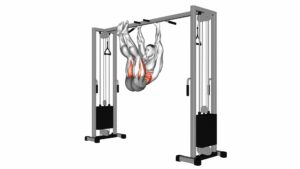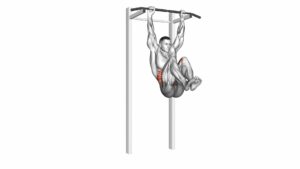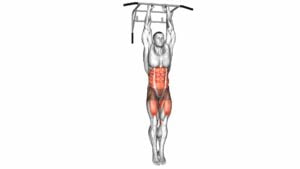Hanging Front Lever Raise (male) – Video Exercise Guide & Tips

Looking to strengthen your core and upper body? Check out this video exercise guide for the Hanging Front Lever Raise. In just a few minutes, you'll learn the proper technique, common mistakes to avoid, and helpful progressions and modifications.
Watch This Exercise Video
Whether you're a beginner or an experienced athlete, this exercise can be incorporated into your workout routine to challenge and improve your strength.
Get ready to take your fitness to the next level with the Hanging Front Lever Raise.
Key Takeaways
- Hanging Front Lever Raise improves core strength and shoulder stability.
- Proper technique includes maintaining control, avoiding swinging or momentum, and keeping shoulders down and away from ears.
- Common mistakes to avoid include relying on momentum, not maintaining proper body alignment, and rushing through the exercise.
- Progressions and modifications for the exercise include the one-leg front lever raise, straddle front lever raise, and advanced front lever raise.
Benefits of the Hanging Front Lever Raise
The hanging front lever raise provides a multitude of benefits for you as a male athlete. This exercise is highly effective in improving core strength and increasing shoulder stability.
When performing the hanging front lever raise, your core muscles are engaged throughout the movement, working to stabilize your body and maintain proper alignment. This leads to a stronger and more stable core, which is essential for various athletic movements and activities.
Additionally, the hanging front lever raise targets your shoulder muscles, particularly the deltoids and rotator cuff. As you raise your legs while hanging from a bar, your shoulders are required to work hard to maintain stability and control. Over time, this exercise helps to strengthen the muscles surrounding your shoulder joints, reducing the risk of injuries and improving overall shoulder stability.
By incorporating the hanging front lever raise into your training routine, you can expect to see improvements in your core strength and shoulder stability. These benefits won't only enhance your performance as a male athlete but also contribute to better posture, increased power, and improved overall athletic ability.
Proper Technique for the Hanging Front Lever Raise
To execute the hanging front lever raise properly, focus on engaging your core and maintaining control throughout the movement. Start by hanging from a pull-up bar with an overhand grip, keeping your arms shoulder-width apart. Engage your core by pulling your belly button towards your spine and squeezing your glutes.
From this position, slowly raise your legs while keeping them straight. As you lift your legs, focus on maintaining control and avoiding any swinging or momentum. Keep your body straight and parallel to the floor, aiming to form a lever with your body. Once you reach the highest point, slowly lower your legs back to the starting position while maintaining the same control and engaging your core.
It's important to note that this exercise requires a considerable amount of strength and flexibility, so it's essential to start with proper technique and gradually increase the difficulty level. By mastering the proper technique, you can effectively target your core muscles and work towards achieving a full hanging front lever.
Now, let's move on to the next section to discuss common mistakes to avoid during the hanging front lever raise.
Common Mistakes to Avoid During the Hanging Front Lever Raise
Avoid swinging or using momentum when performing the hanging front lever raise. One common mistake to avoid is relying on your body's momentum to complete the movement. This not only diminishes the effectiveness of the exercise but also increases the risk of injury.
To perform the hanging front lever raise correctly, engage your core muscles and use controlled movements. Another mistake to avoid isn't maintaining proper body alignment. Make sure your body is straight and parallel to the ground throughout the exercise. Avoid arching your back or letting your legs drop. Keep your shoulders down and away from your ears to maintain proper shoulder positioning.
Lastly, avoid rushing through the exercise. Take your time and focus on maintaining proper form and control. By avoiding these common mistakes and focusing on proper technique, you can maximize the benefits of the hanging front lever raise while minimizing the risk of injury.
Progressions and Modifications for the Hanging Front Lever Raise
To continue the discussion of progressions and modifications for the hanging front lever raise, you can enhance the exercise by incorporating advanced variations and increasing the difficulty level. Here are three ways to progress and modify the hanging front lever raise:
- One-Leg Front Lever Raise: Begin by performing the exercise with both legs, but gradually progress to raising one leg at a time. This variation challenges your core stability and increases the demand on your upper body strength.
- Straddle Front Lever Raise: Once you have mastered the regular front lever raise, you can progress to the straddle variation. Start by spreading your legs apart while performing the exercise. This modification increases the difficulty by requiring more strength and control.
- Advanced Front Lever Raise: For those who are looking for an even greater challenge, the advanced front lever raise is the way to go. In this variation, you lift your legs higher, aiming to bring your body parallel to the ground. This requires exceptional core strength and control.
By incorporating these progressions and variations into your hanging front lever raise routine, you can continue to challenge yourself and make consistent gains in strength and stability.
Now, let's move on to the next section where we'll discuss some tips for incorporating the hanging front lever raise into your workout routine.
Tips for Incorporating the Hanging Front Lever Raise Into Your Workout Routine
Now let's dive into some tips on how you can effectively incorporate the hanging front lever raise into your workout routine. For advanced athletes, there are variations of this exercise that can provide an additional challenge.
One variation is the straddle front lever raise, where you perform the exercise with your legs spread apart. This variation increases the difficulty by adding more weight to your upper body.
Another variation is the one-leg front lever raise, where you raise one leg while keeping the other extended. This variation targets your core and stabilizing muscles even more intensely.
To increase grip strength for the hanging front lever raise, there are a few exercises you can incorporate into your training.
One effective exercise is the farmer's carry, where you hold heavy weights in each hand and walk for a certain distance or time. This exercise challenges your grip strength and helps to develop the muscles needed for the hanging front lever raise.
Another exercise is the towel pull-up, where you hang a towel over a pull-up bar and grip the ends to perform pull-ups. This exercise specifically targets your grip strength and can greatly improve your ability to perform the hanging front lever raise.
Incorporating these variations and grip strengthening exercises into your workout routine will help you progress with the hanging front lever raise and improve your overall upper body strength. Remember to start with proper form and gradually increase the difficulty as you become more comfortable and stronger.
Frequently Asked Questions
How Long Does It Take to Master the Hanging Front Lever Raise?
To master the hanging front lever raise, it takes time and dedication. Start by focusing on building overall strength and core stability.
Gradually progress by increasing the difficulty of the exercise. Avoid common mistakes such as using momentum or swinging your body. Instead, engage your muscles and control the movement.
With consistent practice and proper form, you can eventually master the hanging front lever raise.
Can Women Also Perform the Hanging Front Lever Raise?
Yes, women can also perform the hanging front lever raise. While the exercise may be challenging, there are modifications you can make to suit your fitness level.
Performing this exercise can have several benefits, including strengthening your core, back, and upper body muscles. It also helps improve your grip strength and overall body control.
With practice and consistency, you can master the hanging front lever raise and achieve impressive results.
What Muscles Does the Hanging Front Lever Raise Target?
The hanging front lever raise is a challenging exercise that targets multiple muscles in your upper body. It primarily activates your latissimus dorsi, which are the large muscles in your back.
Additionally, it engages your core muscles, including your abdominals and obliques, for stability and control.
As you progress with this exercise, you can work towards achieving a full front lever position, which requires even more strength and muscle activation throughout your entire body.
Can the Hanging Front Lever Raise Help Improve Other Exercises, Such as Pull-Ups?
The hanging front lever raise is a great exercise for improving core strength. By targeting your core muscles, this exercise helps to stabilize your body and build overall strength. As you progress with the hanging front lever raise, you'll develop better control and stability. This will make other exercises, like pull-ups, easier to perform. Keep practicing and incorporating progressions to continue improving your core strength and overall fitness.
Are There Any Specific Warm-Up Exercises Recommended Before Attempting the Hanging Front Lever Raise?
Before attempting the hanging front lever raise, it's important to perform specific warm-up exercises to prepare your body. These warm-up exercises should focus on activating the muscles used in the hanging front lever raise, such as your core, back, and shoulders.
Incorporating exercises like planks, scapular retractions, and shoulder mobility drills will help to loosen up your muscles, improve your range of motion, and reduce the risk of injury during the exercise.
Conclusion
In conclusion, the hanging front lever raise is an effective exercise for developing core and upper body strength. By following proper technique and avoiding common mistakes, you can maximize the benefits of this exercise.
Progressions and modifications allow for customization based on individual fitness levels. Incorporating the hanging front lever raise into your workout routine can help you achieve your fitness goals and improve overall strength and stability.

Author
Years ago, the spark of my life’s passion ignited in my mind the moment I stepped into the local gym for the first time. The inaugural bead of perspiration, the initial endeavor, the very first surge of endorphins, and a sense of pride that washed over me post-workout marked the beginning of my deep-seated interest in strength sports, fitness, and sports nutrition. This very curiosity blossomed rapidly into a profound fascination, propelling me to earn a Master’s degree in Physical Education from the Academy of Physical Education in Krakow, followed by a Sports Manager diploma from the Jagiellonian University. My journey of growth led me to gain more specialized qualifications, such as being a certified personal trainer with a focus on sports dietetics, a lifeguard, and an instructor for wellness and corrective gymnastics. Theoretical knowledge paired seamlessly with practical experience, reinforcing my belief that the transformation of individuals under my guidance was also a reflection of my personal growth. This belief holds true even today. Each day, I strive to push the boundaries and explore new realms. These realms gently elevate me to greater heights. The unique combination of passion for my field and the continuous quest for growth fuels my drive to break new ground.



